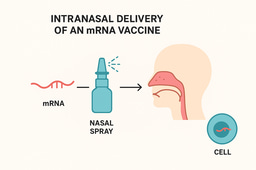Breakthrough in COVID-19 Vaccination: Single-Cycle Virus Shows High Protection and Blocks Transmission
Published in Microbiology and Immunology

The Challenge of COVID-19 Variants
Since the emergence of COVID-19 in 2019, vaccination efforts have focused on creating immunity against the virus. Early vaccines, such as mRNA-based technologies (like Pfizer-BioNTech and Moderna), effectively reduced severe illness and death. However, as the virus evolves, new variants escape the immunity these first-generation vaccines provide, reducing the overall effectiveness.
In light of these challenges, scientists have been searching for new vaccine strategies that protect against disease and prevent the virus from spreading to others. This transmission-blocking capability is crucial for controlling pandemic/endemic outbreaks.
Enter the Single-Cycle Virus Vaccine
The study introduces a "single-cycle infection virus" (SCV) as a novel approach to COVID-19 vaccination. The SCV is based on the SARS-CoV-2 virus but cannot fully replicate. It completes only one round of infection, which limits the risk of causing disease while still triggering a strong immune response in the vaccinated individual.
The SCV is designed with specific gene deletions, including the Envelope (E) gene, which is crucial for viral replication and budding. Without this gene, the virus cannot propagate, making it a safer option, particularly for immunocompromised individuals. The additional removal of other immune-suppressing genes, such as ORF6 and ORF8, further enhances the immune response triggered by the SCV vaccine.
How Was It Tested?
To assess the safety and effectiveness of this new vaccine, the researchers conducted experiments in Syrian hamsters, a well-established model for studying COVID-19 due to their susceptibility to the virus. The animals were vaccinated through the nose with the SCV and later exposed to the wild-type SARS-CoV-2 virus to see how well they were protected.
Promising Results
The study results were remarkable. Vaccinated hamsters displayed full protection against the virus, with no signs of weight loss, lung damage, or tissue inflammation—symptoms typically associated with severe COVID-19 infection. In contrast, unvaccinated control hamsters lost weight and developed severe lung disease upon infection.
One of the most exceptional findings was that the SCV-immunized hamsters completely blocked virus transmission. When these animals were co-housed with unvaccinated hamsters after exposure to a high dose of SARS-CoV-2, the virus did not spread to the unvaccinated animals. This underscores that the vaccine not only protects vaccinated individuals but also prevents virus transmission to other unprotected individuals—an essential feature for controlling pandemics.
Strong Immune Response
The vaccine triggered a robust immune response in the hamsters, with both systemic (whole-body) and mucosal immunity. Mucosal immunity is particularly important because it targets the natural infection route of SARS-CoV-2, i.e., the nasal mucosa and the upper respiratory tract. Vaccinated animals produced high levels of neutralizing antibodies and secretory, local antibodies (IgA) in their nasal and lung tissues, offering strong protection at the site of infection.
Interestingly, after the challenge with live SARS-CoV-2, the vaccinated hamsters did not show a significant increase in antibody levels. This indicates that the immune response from the vaccine was already strong enough to neutralize the virus, preventing further immune activation.
Transmission-Blocking: A Key Advantage
A significant advantage of this single-cycle virus vaccine is its ability to block transmission. Even with new technologies like mRNA vaccines, vaccinated individuals can still carry and spread the virus, which can be problematic for controlling outbreaks. However, the new SCV concept stopped the virus from spreading in the sensitive hamster model, suggesting its high value to use as an effective tool to prevent further waves of COVID-19 in human populations.
Safer for Immunocompromised Individuals
Unlike traditional live attenuated vaccines, which use a weakened form of the virus, the SCV cannot revert to a fully replicative form. This makes it a much safer option, particularly for people with weakened immune systems, such as the elderly, cancer patients, or those undergoing organ transplants, who need protection most. These individuals are at higher risk of severe outcomes from both COVID-19 and live vaccines. Thus, a non-propagating, single-cycle vaccine could offer much-needed protection without the risks associated with live-attenuated vaccines.
A Boost for Future Vaccination Efforts
The SCV approach also offers adaptability for future vaccination strategies. As new variants of SARS-CoV-2 emerge, the vaccine can be easily updated using our CLEVER method, recently published in eLife (https://doi.org/10.7554/eLife.89035.3). This technology allows for rapid modifications of the vaccine to target new variants, ensuring that protection remains strong as the virus continues to evolve.
What’s Next?
The success of this single-cycle virus vaccine in animal models is a major step forward. However, the next critical phase will be clinical trials in humans to determine if the same level of protection and transmission-blocking immunity can be achieved. If successful, this vaccine could offer a more comprehensive solution to COVID-19, addressing both individual protection and community-wide prevention.
Conclusion
This novel single-cycle SARS-CoV-2 vaccine represents a promising advance in the fight against COVID-19. Administered intranasally, it offers a needle-free option that directly targets the primary site of infection, enhancing mucosal immunity. By providing strong systemic and local immunity, blocking transmission, and offering a safer option for vulnerable populations, this vaccine has the potential to be a game changer in stopping transmission chains. As we look to the future, innovations like this will be key to ensuring we are better prepared for any new variants or pandemics that may arise.
(Graphical items in image created in https://BioRender.com)
Follow the Topic
-
npj Vaccines

A multidisciplinary journal that is dedicated to publishing the finest and high-quality research and development on human and veterinary vaccines.
Ask the Editor - Immunology, Pathogenesis, Inflammation and Innate Immunity
Got a question for the editor about the complement system in health and disease? Ask it here!
Continue reading announcementRelated Collections
With Collections, you can get published faster and increase your visibility.
Lipid nanoparticle (LNP)-adjuvanted vaccines
Publishing Model: Open Access
Deadline: Feb 19, 2026
Therapeutic HPV vaccines
Publishing Model: Open Access
Deadline: Dec 31, 2025




Please sign in or register for FREE
If you are a registered user on Research Communities by Springer Nature, please sign in